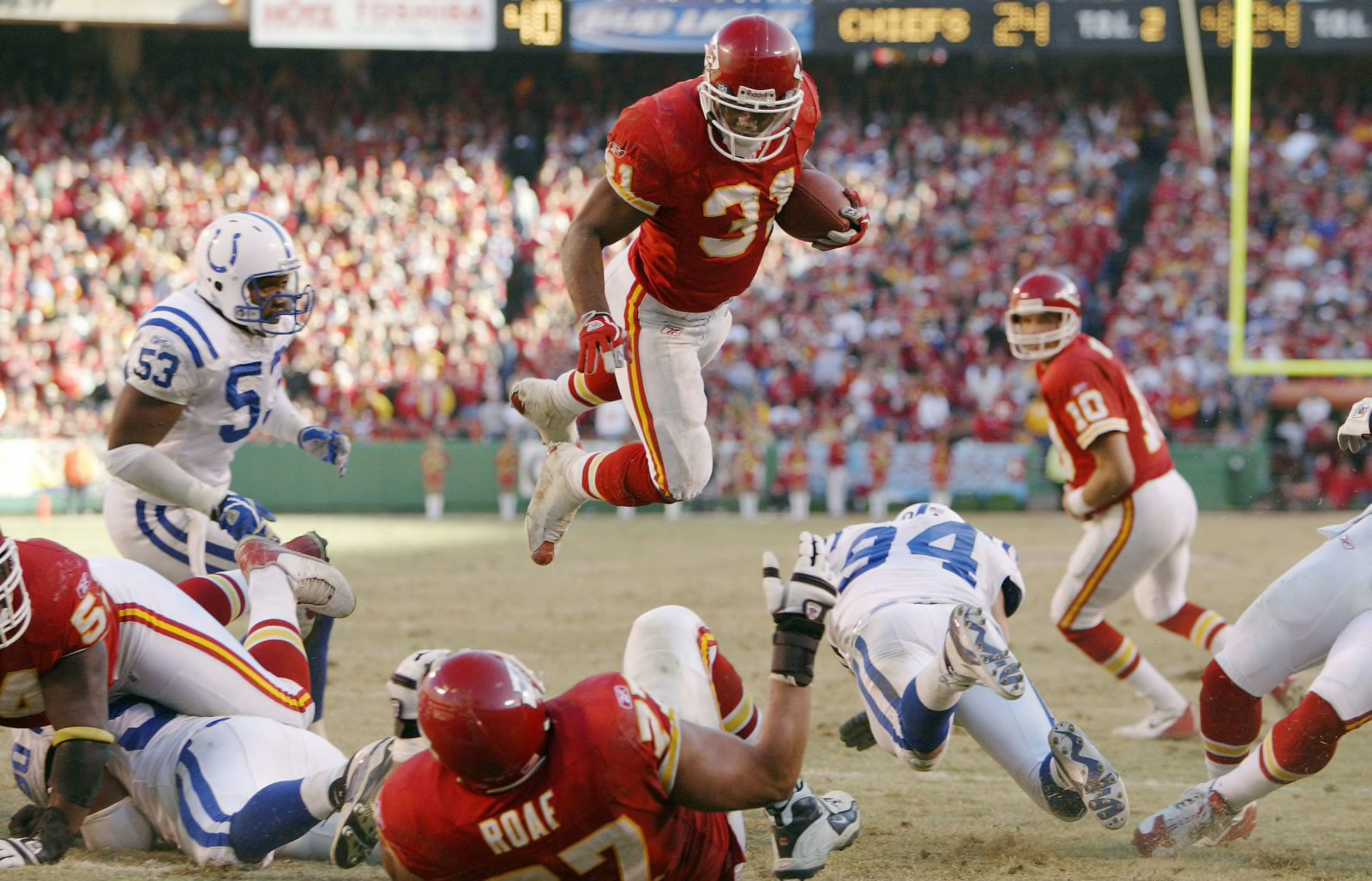Draft Strategies | Depth Charts | Mock Drafts | SOS | Tools | ADP
Diehards Staff Experts Poll | Draft Simulator | University Videos
Forgotten Legendary Pass Catchers in NFL History

The Forgotten Pass Catchers
Legendary PPR-Runners in NFL History
As a kid in the Seventies, I collected comic books. One of my favorites was What If by Marvel, and I’ll never forget reading the first issue: What If Spider-Man joined the Fantastic Four?
By the end of the decade, I had become a huge football diehard and Super Bowl VII was the first one that I watched with my Dad when the Doomsday Defense dismantled Craig Morton and the Denver Broncos 27-10.
I am a full-time history teacher and one of my favorite diversions is observing film of players and teams from different eras. I have often wondered what if the Steeler Curtain defense of the 1970s played the 2007 New England Patriots? Could Sid Gilliams’ high-flying AFL Chargers of the early Sixties score points on the Legion of Boom in 2013? Would Eric Dickerson procure 379 carries and rush for over 2,000 yards in 2018?
It is natural for sports fans to debate the greatest players of all-time. However, I am reluctant because each era is different, and the players of today are so much bigger and faster than those of the Sixties. So, I decided to look at running backs from NFL history and attempt to examine their historical significance in an objective manner, attempting to eliminate bias. I precluded Jim Brown, Emmitt Smith, Marcus Allen, LaDainian Tomlinson, Barry Sanders and Dickerson: There is no denying the magnitude of those Hall of Famers.
With the rise of ppr-scoring in fantasy leagues, I wanted to look at the often forgotten pass-catching running backs in history. I decided to rank the former stars based on yards from scrimmage as a percentage of teams’ total offense and selected ball carriers who are not mentioned among the all-time elites.
If one looks at the raw statistics of Frank Gifford in 1956, it is easy to discount his impact on the field. However, his 38% market share of the Giants total yards from scrimmage provides a much-better perspective on his performance. What if Lydell Mitchell suited up today? Based on his 1975 numbers, he would be a first-round pick in fantasy leagues.
The list is not a comprehensive one. It is intended to examine the dominance of past players who are overlooked in history.
Enjoy my fellow football diehards.
1. Tiki Barber, New York Giants, 2005
When compiling the numbers, I was shocked that Barber adorned the top of the list. The former second-round pick in 1997 may very well be the most overlooked runner in NFL history. He surpassed 1,000 yards rushing six times and concluded his career with five consecutive 1,000-yard crusades. As a Giant, Barber totaled 586 receptions and scored 67 touchdowns. His 2005 campaign is one for the ages: He carried the football 357 times and rushed for 1,860 yards. New York won the NFC East with an 11-5 record; nonetheless, the Carolina Panthers dismantled the Giants 23-0 in the Wild Card Game. At 31-years old, he abruptly retired after the 2006 season, missing the Super Bowl championship campaign in New York. In my humble opinion, Barber is a Hall of Fame talent who should be voted into Canton down the road.
| R-Yrds | Rec. | Team % | Rec. Yrds | Team % | Yrds. Scrim. | Team % | TDs |
| 1,860 | 54 | 18% | 530 | 14% | 2,390 | 40% | 11 |

2. James Wilder, Tampa Bay Buccaneers, 1984
In the 1980s, my best friend and I would travel to the Meadowlands and scalp tickets in the parking lot. It was so cheap that we usually passed through the gate for less than $25 and went to as many games as possible. On November 17, 1985, we went to see the Buccaneers (1-10) play the Jets (8-3), and I was pumped to watch James Wilder, who scored two touchdowns that afternoon. Unfortunately, Wilder produced his magnum opus as a professional the year before. The 1984 season produced record-breaking campaigns by Dan Marino (5,084 passing yards and 48 touchdowns), Eric Dickerson (2,105 rushing yards) and Art Monk (106 receptions). Wilder’s incredible crusade falls into the dustpan of history because of his contemporaries on the gridiron, and the Buccaneers’ lackluster record. At 6-foot-3 and 225 pounds, the former Missouri product produced only one more 1,000-yard campaign before the incredibly high number of carries (772) in back-to-back seasons limited his productivity and shortened his career.
| R-Yrds | Rec. | Team % | Rec. Yrds | Team % | Yrds. Scrim. | Team % | TDs |
| 1,544 | 85 | 25% | 685 | 18% | 2,229 | 39% | 13 |

3. Priest Holmes, Kansas City Chiefs, 2002 & 2003
After leading the Rams to a Super Bowl victory in 1999, coach Dick Vermeil retired for a second time. In 2001, he yearned to be back on the sideline and took control in Kansas City. At 5-foot-9 and 213 pounds, Priest Holmes went undrafted out of Texas and earned a roster spot as a free agent in Baltimore. He gained over 1,000 rushing yards in 1998 and won a Super Bowl ring with the Ravens in 2000. Vermeil signed the discounted free agent before kickoff in 2001, and Holmes career took off in Kansas City. During his first two seasons, the Chiefs posted a 14-18 mark despite an improved offense, which averaged nearly 25 points per game. In 2002, Holmes earned the AP Offensive Player of the Year. In 2003, Holmes scored 27 touchdowns and snatched 74 passes as the Chiefs captured the AFC West with a 13-3 record. Holmes earned First Team All-Pro in each of his first three seasons in Kansas City, totaling 6,566 yards from scrimmage, catching 206 passes and scoring 61 times. Holmes ranks among the paramount free agent signings and best playmakers in NFL history.
| Year | R-Yrds | Rec. | Team % | Rec. Yrds | Team % | Yrds. Scrim. | Team % | TDs |
| 2002 | 1,615 | 70 | 24% | 672 | 18% | 2,287 | 37% | 24 |
| 2003 | 1,420 | 74 | 22% | 690 | 17% | 2,110 | 35% | 27 |
4. Frank Gifford, New York Giants, 1956
If you are over a certain age, your fondest memories of Frank Gifford are likely on ABC Monday Night Football as an announcer. Long before he became a household broadcaster, Gifford starred on both coasts—at USC in the City of Angels and at Yankee Stadium in the Big Apple. A versatile competitor, he played halfback, defensive back and kicker in college. As a senior in 1951, Gifford led USC in rushing and scoring. In 1952, the Giants selected the Trojans’ All-American with the 11th selection in the first round of the Draft. He played 12 seasons in the NFL, earning five Pro Bowl invitations and helping the Giants reach five Championship Games. In 1956, the Giants captured their only NFL Title of the decade beating the Bears 47-7 as Gifford caught four passes for 131 yards and a touchdown. How prodigious was Gifford’s campaign? He led the league in yards from scrimmage and receptions while earning NFL MVP. During his career, the Hall of Famer seized 367 passes and scored 77 times. A forgotten playmaker, Gifford deserves to be recognized as the first great all-purpose back in league history.
| R-Yrds | Rec. | Team % | Rec. Yrds | Team % | Yrds. Scrim. | Team % | TDs |
| 819 | 51 | 38% | 603 | 38% | 1,422 | 38% | 9 |

5. Lydell Mitchell, Baltimore Colts, 1975
In 1974, the Baltimore Colts finished the season 2-12 under coach Howard Schnellenberger. In 1975, the organization hired Ted Marchibroda, and the Colts ascended to the top of the AFC East with a 10-4 mark. During his first three seasons at the helm, Marchibroda guided Baltimore to three consecutive division titles and a 31-11 record. While most Colts’ fans remember QB Bert Jones, the key to the turnaround might have been Lydell Mitchell. Over three seasons, the former Penn State celebrity exceed 1,100 yards rushing and totaled over 60 receptions each year, leading the league with 71 catches in 1977. His 1975 campaign should be recognized among the finest: the all-purpose runner finished third in rushing yards behind O.J. Simpson (1,817) and Franco Harris (1,246), third in yards from scrimmage and fourth in total touchdowns, scoring 15 times. Mitchell accounted for 36% of the teams’ total yards and earned a Pro Bowl invite. He was traded to San Diego following the 1977 season and concluded his career as the leading rusher in Colts’ history with 5,487 yards.
| R-Yrds | Rec. | Team % | Rec. Yrds | Team % | Yrds. Scrim. | Team % | TDs |
| 1,192 | 60 | 28% | 544 | 21% | 1,737 | 36% | 15 |
